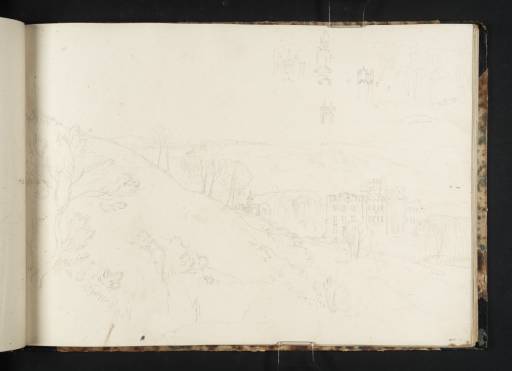Joseph Mallord William Turner Hylton Castle and Chapel, with Architectural Details 1817
Image 1 of 2
Joseph Mallord William Turner,
Hylton Castle and Chapel, with Architectural Details
1817
Joseph Mallord William Turner 1775–1851
Folio 13 Recto:
Hylton Castle and Chapel, with Architectural Details 1817
D12276
Turner Bequest CLVI 10
Turner Bequest CLVI 10
Pencil on white wove paper, 232 x 328 mm
Inscribed by Turner in pencil ‘Corn’ left of centre, ‘Grass’, ‘wall’ and ‘Road’ towards bottom right of main view, ‘5’, ‘5’, and ‘5’ beside a turret among subsidiary sketches top right, and ‘Warden Law’ on a continuation of skyline top right
Inscribed in pencil ‘10’ bottom right
Stamped in black ‘CLVI 10’ bottom right
Inscribed by Turner in pencil ‘Corn’ left of centre, ‘Grass’, ‘wall’ and ‘Road’ towards bottom right of main view, ‘5’, ‘5’, and ‘5’ beside a turret among subsidiary sketches top right, and ‘Warden Law’ on a continuation of skyline top right
Inscribed in pencil ‘10’ bottom right
Stamped in black ‘CLVI 10’ bottom right
Accepted by the nation as part of the Turner Bequest 1856
References
1909
A.J. Finberg, A Complete Inventory of the Drawings of the Turner Bequest, London 1909, vol.I, p.447, CLVI 10, as ‘Hilton Castle’.
1979
Andrew Wilton, J.M.W. Turner: His Life and Work, Fribourg 1979, p.364 under no.556.
Turner’s viewpoint is north-west of the Hylton Castle and its chapel, looking across the Sunderland-Washington road south to the Wear Valley beyond and the Tunstall Hills towards the coast. Sunderland has since expanded over much of the open land beyond the river and the castle itself is surrounded by housing estates. The immediate foreground of Turner’s view remains a grassy slope, although from this angle the castle is largely screened by trees beyond the road.
The near and far wings of the castle have since been demolished and the chapel has lost its tower and roof. Isolated details of the chapel and castle appear towards the top right, where there are also continuations of the trees seen in the main composition below and of the skyline at Warden Law, a prominent hill near Houghton-le-Spring about five miles to the south.
Turner followed this sketch closely in his watercolour of about 1817 (private collection),1 engraved in 1820 as Hylton Castle, Co. of Durham for Surtees’s History of Durham (see the introduction to the tour). He omitted the prominent tree on the left and the windmill above it and did not extend the composition to the right, while his notes of the corn and road prompted the introduction of reapers and a hay wagon at the respective points, as well as a rustic couple in the foreground and sheep just below the castle. A colour study for the composition introduces deeper shadow in the foreground and shows the west front of the castle in brilliant light (Tate D17206; Turner Bequest CXCVII P).
Technical notes:
A short tear has been repaired towards the left of the bottom edge. Next to it is a small, adventitious blot of dark, greyish ink or watercolour, possibly a by-product of the finished watercolour described above. The pencil number ‘10’ on the present leaf may obscure or reinforce John Ruskin’s customary red ink foliation, which is evident only faintly and intermittently in this much-rearranged book (see the introduction to the sketchbook).
Verso:
Blank, save for inscription by John Ruskin in red ink ‘555’ bottom left. There are abrasions to the surface towards the top left.
Matthew Imms
February 2010
How to cite
Matthew Imms, ‘Hylton Castle and Chapel, with Architectural Details 1817 by Joseph Mallord William Turner’, catalogue entry, February 2010, in David Blayney Brown (ed.), J.M.W. Turner: Sketchbooks, Drawings and Watercolours, Tate Research Publication, December 2012, https://www


